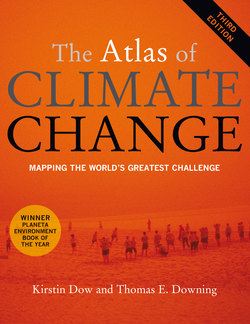Читать книгу The Atlas of Climate Change - Professor Kirstin Dow - Страница 14
На сайте Литреса книга снята с продажи.
Оглавлениеproducers, while a crop loss for one area may create an economic windfall for another. The risks are pervasive, and also critical in the distribution and functioning of ecosystems. Many ecosystems are currently under tremendous pressure from land-use change and over-harvesting. Climate change is emerging as another unavoidable stress that will require action to support adaptation to multiple stresses. A broad front of adaptation is being pursued. Community-based adaptation focuses on livelihoods and local action. Sectoral actions look to promote climate resilience. National plans set policy frameworks, monitor outcomes and support finance. Social networking and information platforms are now common. Concerted urban adaptation programmes have gained momentum in the past five years. However, there are limits to adaptation. The ability of entire ecosystems to shift is uncertain, both because the rate of change is faster than typical ecological timescales, and because there is limited space available to move. The area immediately surrounding protected areas and coastal areas is often already in use and, in the far north and on mountain tops, there are no more options. Social, institutional, and economic barriers to restructuring infrastructure and economic wellbeing may well be insurmountable. Imagine trying to rebuild a city like Mumbai to cope with the plethora of climate risks it already experiences. And to do that for every coastal city. Climate change touches everything, and everyone The breadth of climate change is enormous. From the complexity of the science to the dimensions of impacts, from the structures of vulnerability to the transformations required in economic relationships. The lens of climate change reveals much about the interconnectedness of our world. The many dimensions of complexity and the difficulties they pose for generating solutions makes climate change what some academics have identified as a wicked environmental problem. These wicked traits are part of the way climate change both creates and requires new types of connections among us and future generations: • The solution depends on how the problem is framed – no single solution can solve the full breadth of climate change, so we have to break it down into parts that can be addressed. Witness the negotiations to appreciate the herculean task of creating pieces that can garner agreement. • Stakeholders have radically different frames for understanding the problem – whether formal regimes or cultural personalities, we describe the causes and solutions to climate change quite differently. Some see it as a problem of the global commons, others frame solutions through economic growth with new technology. • There is no central authority – the UNFCCC is a coordinating framework but cannot impose solutions. • The long term is valued more than expected – scenarios of policy effects and residual impacts are routinely run out to 2100, and some explore even longer horizons. • The problem is never solved definitively – actions we take today will not make the climate challenges disappear. We are already committed to impacts for at least another 100 years. • Those who are trying to solve the problem are also the cause – the imbalance between industrial emissions over the past century (largely North America and Europe) and the next century (with the BASIC countries taking a large share) plagues the negotiations; or more personally, wealthy consumers are also the political elite. • Time is running out – how long we have before the climate challenge becomes unsolvable is a critical question, and not just academic. Solutions will require “all hands on deck”. All levels of effort, from individuals to cities, to nations, corporations, and the international community are needed to meet this challenge. From individuals taking part in public demonstrations such as the 350 movement, to business councils offering toolkits for reductions, to strong national programs and active international negotiations, this engagement is taking place. An encouraging sign is the rising role of social entrepreneurs. New leadership is coming forward at all levels, personally committed to taking action. New initiatives, companies, and web services are launched every day. Action on climate change is a part of diverse global and local movements. It is grounded in environmental science and action, and in concerns for sustainability. It is often linked to other environmental issues, such as ozone depletion, or economic trends, such as the peak in oil production. Our experience of climate change is intimately exposed in the record of natural disasters. And disaster reduction has a humanitarian urgency as we seemingly lurch from crisis to crisis. We have much to learn. Learning pathways need to be constructed, scaling up success. Such pathways are journeys through the challenging landscape in three particular ways. First, is the action of each of us. There is much we can do in our own lives and within the remits of our own organizations. Promoting a positive psychology of action is essential. The second level of a journey often comes close upon our individual spheres of action. At some point we must involve others. This may be as simple as achieving a scale of action to warrant investment in a new technology –
14
